
Attracting and Retaining Key Personnel in a Competitive Economic and Business Environment
In a competitive business and economic environment where human resources are in the centre of a company’s success or failure, attracting and retaining the right key people can have a significant impact on an organization’s success.
To foster a strong team, a company’s senior management and HR function benefit from a powerful tool: long-term incentive plans, also known by its acronym: LTIPs.
In this article, we present the benefits of LTIPs, while democratizing and simplifying the decision-making elements for this type of compensation and retention strategy. We will cover the basics as well as the four main families of plans, and highlight the key success factors.
Although the impact of this type of compensation strategy has been very well demonstrated in practice and within the business community, our Quebec Total Rewards Survey 2023 demonstrates some surprising facts, including that:
- Only 36% of organizations target high potentials; and
- Only 25% have a succession planning program.
These results are noteworthy in a context where nearly 60% of companies intend to sell or transfer their business within a maximum timeframe of 10 years[1]. LTIPs are therefore one of the solutions to consider.
What is a Long-Term Incentive Plan?
A LTIP is added to standard compensation programs such as a salary structure, variable compensation and short-term bonuses as part of the company’s overall compensation strategy. A LTIP generally pays off when companies or employees results are positive, and when the target workforce is employed.
Who Can Benefit from Long-Term Incentive Plans?
LTIPs can be addressed to all members of an organization. That being said, given their tax, legal and financial complexities, they are generally reserved for the organization’s key people.
Although all members of a company are important, key people generally have some or all of the following characteristics:
- Are the pillars of the organization;
Influence a large part of business volume; - Have a major impact on profitability and, consequently, on the company’s market value;
- Are versatile and therefore able to perform several important functions;
- Have specific, cutting-edge expertise crucial to the business;
- Have an outstanding, stable performance.
There are many other potential qualification criteria, but the most seen in practice are those listed above. A simple Roles and Responsibilities Identification Exercise (RASCI) can help highlight these components and identify which functions and key people are necessary for the success of your business.. We invite you to consult our article “RASCI, a responsibility management matrix” on our website.
In addition, here are the eligibility criteria:

Why Set Up a Long-Term Incentive Plan?
An LTIP aims to align the interests of key people with those of the company by offering them financial incentives based on the company’s long-term performance. When properly selected and designed, such a plan fosters business success and generates increased profitability and organizational growth.
In addition, the LTIP contributes to the long-term sustainability of the company and maximizes its market value. The LTIP encourages staff to contribute to the company’s long-term growth and success, while offering them the opportunity to share in the benefits of this growth. Such a strategy also offers shareholders the opportunity to share risk with key people, since, as a general rule, an LTIP rewards effort when the organization’s results are favorable.
What Types of Long-Term Incentive Plans are There?
Here are a few examples of long-term incentive schemes that can be set up within your organization:
- Stock option plans;
- Phantom stock plans;
- Direct shareholding;
- Indirect shareholding (trusts, cooperatives, EmployéCo);
- Standard deferred bonus (1 to 3 years);
- Retirement mechanisms;
- And many more!
How to Choose the Right Long-Term Incentive Plan?
Investments in an LTIP can be very substantial. In some cases, it can amount to several million dollars over the long term for the entire program. The risk of negative perception and reaction by key people needs to be considered in the design of the plan, as well as in the way it is communicated to them. Furthermore, the individuals benefiting from such a plan are generally the most important people to the organization’s success. It is therefore highly recommended to carry out a precise and comprehensive exercise to select, design and communicate the LTIP.
The main factors to consider are:
- Organization’s business strategy and strategic planning;
- Shareholders’ intentions and needs;
- Level of competitiveness of the total rewards program (see our article “Distinctive Total Rewards Offer” on this subject);
- Needs and interests of the key persons;
- Level of legal, financial and tax literacy of targeted and potential key persons;
- Conditions of grant, acquisition and monetization (performance, time, events, etc.);
- Eligibility and retention criteria;
Etc.
When properly selected, designed and communicated, an LTIP has a very significant impact on an organization’s business success, its value and solidity, as well as on the fulfillment of shareholders’ objectives and needs. LTIPs are tools to be considered in the package of available compensation strategies. Experience shows us many successful entrepreneurial stories where LTIPs have played a key role in attracting, mobilizing and retaining exceptional people who make a difference! On the other hand, we have also witnessed programs that have had the opposite effect, because they were poorly designed from the outset.
Stay Informed
Stay tuned! In future articles on LTIPs, we will look at the key factors and pitfalls to avoid when setting up an LTIP, the ongoing management of LTIPs, and how an LTIP can support your business transfer strategy (succession).
To find out more
- Contact us to discuss this topic: Miguel Yargeau, associé, 1 844 220-8008, poste 486, myargeau@solertia.ca
- Listen to a recent conference given by our experts: Total Compensation for Key People: A Strategic and Integrated Approach (Private Companies in Quebec) (Online) In French only
[1] « Vers une culture entrepreneuriale », Indice entrepreneurial Québécois, réseau mentorat, édition 2022, format PDF, p.15.
Partager
Publications
In 2020, the pandemic drove many employees to work from home, meaning that this year’s in-person ...
Is your Company federally regulated? (Click here for a handy infographic: https://www.canada.ca/en/services/jobs/workplace/federally-regulated-industries/federal-labour-standards.html) If so, it’s time ...
2020 is finally behind us, but the effects of this pivotal year marked by the COVID-19 ...



